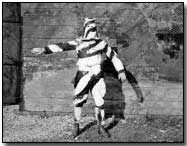Encyclopedia - Snipers
 While sniping was both a
recognised military practice and hobby (the hunting of birds or big-game)
was known to date back at least until the eighteenth century it had not been
developed as a professional arm of the warring armies of Europe in 1914. Early proponents of sniping
in the First World War tended to be talented amateurs drafted in to the
armed services once it became clear that this peculiar brand of war was
ideally suited to the static conditions of
trench
warfare.
While sniping was both a
recognised military practice and hobby (the hunting of birds or big-game)
was known to date back at least until the eighteenth century it had not been
developed as a professional arm of the warring armies of Europe in 1914. Early proponents of sniping
in the First World War tended to be talented amateurs drafted in to the
armed services once it became clear that this peculiar brand of war was
ideally suited to the static conditions of
trench
warfare.
Big-game hunters such as Hesketh Hesketh-Prichard worked hard to transform the quality and practice of sniping within each army. Prichard was to later publish a summary of his work, Sniping in France (1920).
Training schools were established in each of the belligerent armies. Civilian rifles - even elephant guns - were initially issued until standard army rifles were modified to suit the requirements of sniping; optics in particular required substantial development. The German Army quickly arranged for telescopes to be attached to their G98 service rifle. So-called 'hyposcopes' were developed which enabled rifles to be fired from below the parapet line.
Snipers operated on all sides during the war; Turkish sniping proved an especial problem for Allied troops based in Gallipoli. In static trench conditions the ever-present danger of snipers ensured that it was a foolhardy soldier who raised their head or arms above parapet-level, even fleetingly.
The quality of sniping was such that fatalities were common even where men exposed themselves to fire for a fraction of a second. In part this was because snipers were expected to thoroughly accustom themselves to the layout of the land which fell within their domain - which included the exact composition of enemy trench lines. Eagle-eyed sharpshooters proved extraordinarily deft in detecting slight changes in geography.
Nevertheless snipers were reluctant to fire unnecessarily at anything but a certain target. Once the enemy was able to detect the locale from which a sniper operated artillery would be promptly despatched to wipe out the sniper's post. It was therefore a highly dangerous occupation.
Captured snipers could expect scant consideration from the enemy, particularly given that snipers would often be expected to shoot men involved in entirely peaceful tasks behind the enemy line. Civilian snipers - franc-tireurs - were regarded with even less favour and were relatively common within occupied Belgium during the early months of the war.
Snipers invariably operated in pairs. The sniper would usually be accompanied by an observer who would often make use of a periscope ('sniperscopes') in order to scour the surrounding countryside. The nature of such a telescope rendered the observer less likely to fall casualty to enemy snipers in turn. Both sniper and observer would wear camouflage uniforms to further obscure their presence.
Successful snipers, usually acting under the direction of battalion headquarters, were sometimes inclined to keep tallies of their 'score', as was the case with airmen. Their most valued targets were inevitably officers and specialist servicemen. In retaliation each army also trained sniper hunters (including the poet Julian Grenfell).
A Kite Balloon was an observation balloon controlled by a cable from the ground.
- Did you know?
